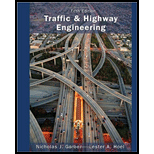
Concept explainers
The traffic characteristics with each of the levels of service for primary freeway sections.
Explanation of Solution
Introduction:
Level of service is a qualitative method which is used to describe the operating conditions of a given freeway segment. This method uses density as the variable and alphabetic grading system raging between A to F.
There is 6 basic level of service, which is described below.
- Level of service A.
- Level of service B.
- Level of service C.
- Level of service D.
- Level of service E.
- Level of service F There is a complete blockage in the traffic flow.
The vehicles move freely within the traffic stream without any interruption. Effect of incidents or point breakdown is easily absorbed.
Traffic moves under reasonably free flow condition with minimum restrictions. Effect of incidents or point breakdown is easily absorbed.
The speed of the vehicles is almost equal to free flow speed, but the free flow of the vehicles is constrained. The driver has to be cautious while shifting lanes. Small incidents are absorbed but large incidents direct to queuing of vehicles.
In the traffic stream, the free movement of vehicles is very much restricted, and there is no level of comfort. Even a minor incident leads to queuing of vehicles.
There are no good gaps between the vehicles, and the operations are unbalanced. The entry of vehicles from ramps or sub-lane leads to a blockage in the traffic flow.
Conclusion:
There are six levels of service which are represented alphabetically from A to F. Level of service A being the ideal for driving with decreasing free flow and level of service F being congested.
Want to see more full solutions like this?
Chapter 9 Solutions
Traffic and Highway Engineering - With Mindtap
- PLease make sure to show all work and all steps for the image find the magnitude and stressesarrow_forwardShowing all work and steps find the magnituded and stress ,arrow_forwardWhat is the value of the influence line for the reaction at support A for the beam shown at 5 m to the right of A? Select the reaction at support B to be the redundant. a. 0 kN b. -0.167 kN c. 0.425 kN d. 1.0 kNarrow_forward
- Determine the force in member AB of the truss shown due to a temperature drop of 25°C in Members AB, BC, and CD and a temperature increase of 60°C in member EF. Use the method of consistent deformations. a. 37.34 k b. 0 k c. 28 k d. 46.67 karrow_forwardWhat is the approximate axial force in girder EF of the frame shown? Use the portal method. a. 32 kN b. 60 kN c. 12 kN d. 20kNarrow_forwardDetermine the vertical reaction at C for the beam shown and support settlements of 1" at B and ¼" at C. a. 27.0 k b. 28.3 k c. 43.7 k d. 21.0 karrow_forward
- What is the horizontal reaction component at D for the frame shown? a. 75.00 kN b. 91.67 kN c. 70.31 kN d. 4.69 kNarrow_forwardFind the vertical reaction at D for the frame shown and a settlement of 50 mm at support D. a. 80.7 kN b. 112.5 kN c. 144.3 kN d. 6.51 kNarrow_forwardDetermine if the W14x 22 beam will safely support a loading of w= 1.5 kip/ft. Theallowable bending stress is oallow = 22 ksi and the allowable shear stress is Tallow = 12 ksi.arrow_forward
- What is the fixed end moment FEMAB for the beam shown with a settlement of 1.2 in. at support B? a. -102.7 ft-k b. -95.2 ft-k c. -307.7 ft-k d. 279.8 ft-karrow_forwardSuggest an optimum footing size and shape (minimum area footing), if the vertical loading (includingthe weight of the footing) is 40 kips, and the soil has the following characteristics: c=200 psf, φ=370,and γ=120.0 lb/ft 3. Constraints of the solution are: the maximum dimension of any side of thefooting is 10 ft, and the depth of embedment is between 2 and 4 ft.arrow_forward15.6 A mountain stream flows over a rocky streambed. Apply the Limerinos and Chezy equations to calculate the discharge. The stream has an intermediate rock size d 84 of 30 cm, an average depth of 2.1 m, a slope of S = 0.0037, and a width of 52 m. In SI units, what is the discharge? a. 85, b. 120, c. 160, d. 240, or e. 410.arrow_forward
 Traffic and Highway EngineeringCivil EngineeringISBN:9781305156241Author:Garber, Nicholas J.Publisher:Cengage Learning
Traffic and Highway EngineeringCivil EngineeringISBN:9781305156241Author:Garber, Nicholas J.Publisher:Cengage Learning
